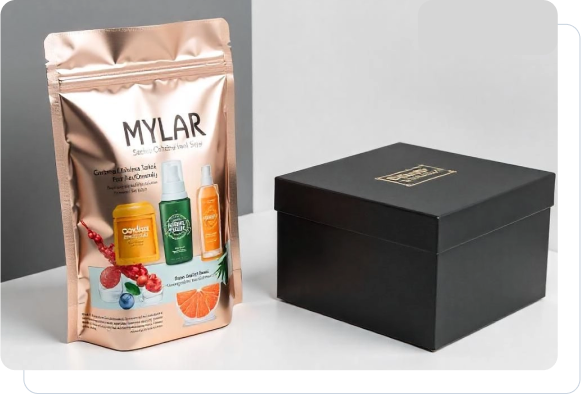Businesses commonly evaluate Mylar packaging against Kraft paper for their selection needs. The materials have different roles for specific needs, even though their individual characteristics diverge substantially. The understanding of material distinctions enables businesses to identify which solution provides optimal results for food preservation and distribution in addition to sustainable packaging solutions.
1. Kraft Paper vs. Mylar: Key Differences
Kraft Paper stands in contrast to Mylar regarding their durability levels and barrier properties, and overall cost factors, as well as their environmental impact and customization capabilities. The material composition of Kraft Paper consists of wood pulp, whereas Mylar functions as a polyester film, which shows excellent barrier properties and strong durability.
|
Feature |
Kraft Paper |
Mylar |
|
Material Composition |
Wood pulp |
Polyester film (BoPET) |
|
Durability |
Moderate |
High |
|
Moisture Resistance |
Low |
Excellent |
|
Oxygen Barrier |
Low |
High |
|
Biodegradability |
Yes |
No |
|
Recyclability |
Yes, but varies |
Limited |
|
Customization |
High |
Moderate |
|
Cost |
Lower |
Higher |
|
Temperature Resistance |
Moderate |
Excellent |
|
Tear Resistance |
Moderate |
High |
2. Durability: Which Material Lasts Longer?
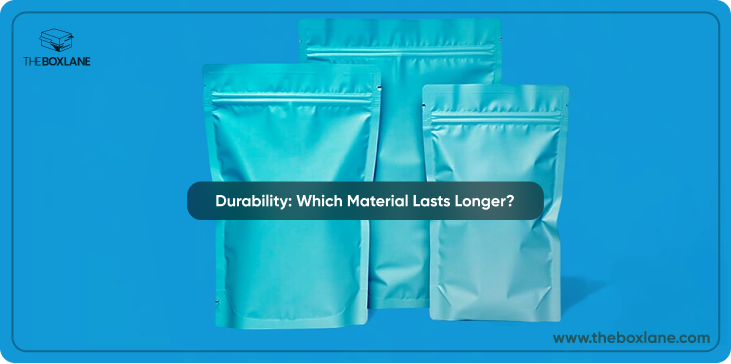
The durability, along with strength, makes Mylar superior to Kraft Paper in terms of long service life. Mylar material demonstrates excellent resistance to tearing and puncture, and water exposure, which makes it a perfect solution for long-term food preservation and sealed packaging applications. Kraft Paper shows vulnerability to damage during use, yet it provides adequate strength for packaging dry merchandise and retail displays.
3. Environmental Impact: Kraft Paper vs. Mylar
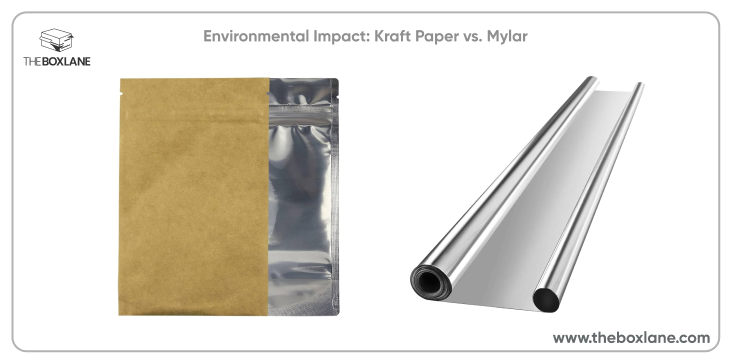
Does Kraft Paper Achieve Better Eco-Friendliness Than Mylar?
The key sustainability features of Kraft Paper include its ability to decompose, break down through compost, and its potential for recycling. Mylar does not degrade naturally and displays restricted availability for recycling. Most waste management systems face difficulties when it comes to recycling Mylar, despite some programs having acceptance policies.
4. Cost Comparison: Is Kraft Paper More Economical?
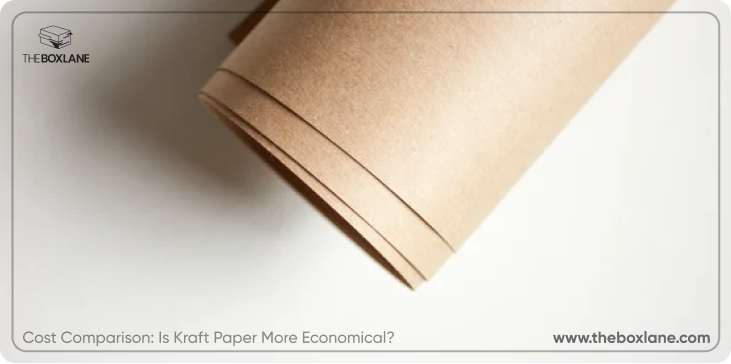
The purchase of bulk Kraft Paper results in lower costs than Mylar materials. Kraft Paper serves as a preferred choice for business packaging needs because of its cost-effective qualities during shipping and product protection and branding requirements. The expense of Mylar is warranted by its remarkable durability and lengthy product lifespan for particular usage requirements.
5. Moisture Resistance: Which Material Protects Better?
Mylar surpasses all other materials when it comes to protecting food from moisture damage, so it works well as food storage packaging. The material stops moisture from impacting products, thus maintaining their fresh state over longer durations. The uncoated Kraft Paper becomes unsuitable for wet or perishable goods because it absorbs moisture.
6. Food Storage: Kraft Paper vs. Mylar
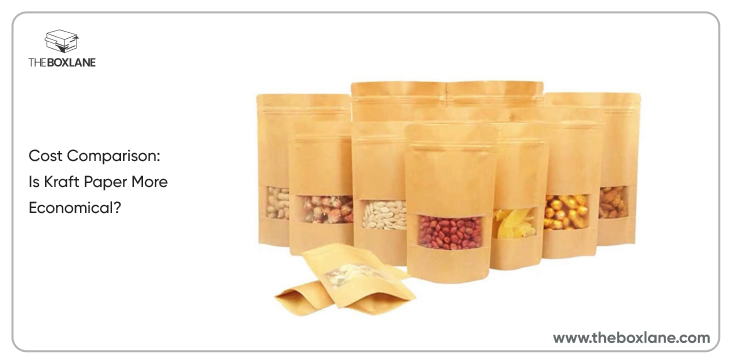
Kraft Paper functions as an acceptable solution for dry food preservation, although Mylar represents the optimal choice for extended storage needs. The airtight packing design, along with its oxygen barrier, prevents food spoilage effectively. Mylar bags preserve grains and coffee and freeze-dried foods, yet Kraft Paper best suits flour, along with bread and nuts.
7. Aesthetic Appeal: Which Material Looks Better?
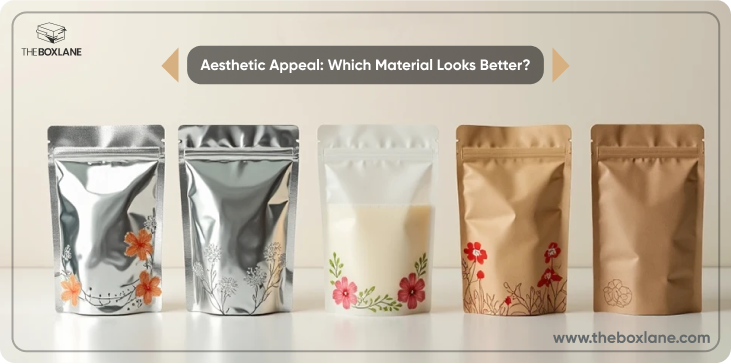
Because of its organic yet rustic and environmentally friendly characteristics, Kraft Paper finds broad use in brand identity applications and customized packaging solutions. The reflective surface of Mylar creates a sleek appearance that serves modern high-end packaging needs, mostly in luxury products and high-tech applications.
8. Common Uses of Kraft Paper and Mylar

Applications of Kraft Paper
- Retail packaging for eco-conscious brands
- Shipping bags for dry goods
- Compostable packaging
- Paper pouches for coffee and tea
Applications of Mylar
- Food storage bags with oxygen absorbers
- Medical and pharmaceutical packaging
- Electronics and industrial packaging
- Vacuum-sealed and heat-sealed bags
9. Customization: Which Material is Easier to Modify?
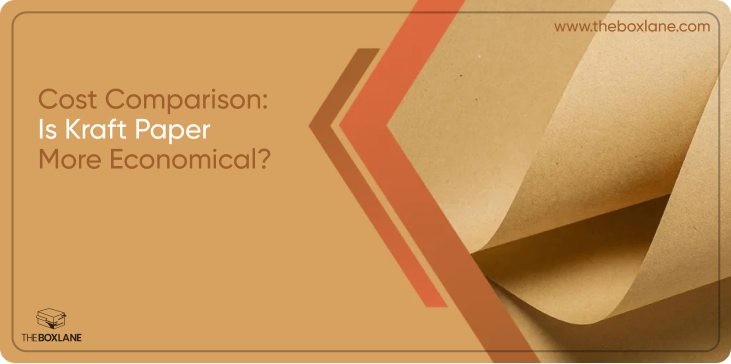
Users achieve higher levels of customization through the use of Kraft Paper compared to Mylar. Due to its printing and shaping capabilities as well as easy embossing properties, Kraft Paper serves well for branding purposes and customized package designs. Specialized printing equipment is necessary to achieve customizations of Mylar packaging.
10. Barrier Properties: Protection Against Light and Oxygen
Mylar packaging stands out from Kraft Paper because it effectively blocks light and stops oxygen from entering products, thus making it best suited for preserving perishable items. Kraft Paper needs foil or plastic linings to achieve the same level of properties as Mylar.
11. Can Kraft Paper and Mylar Be Combined?
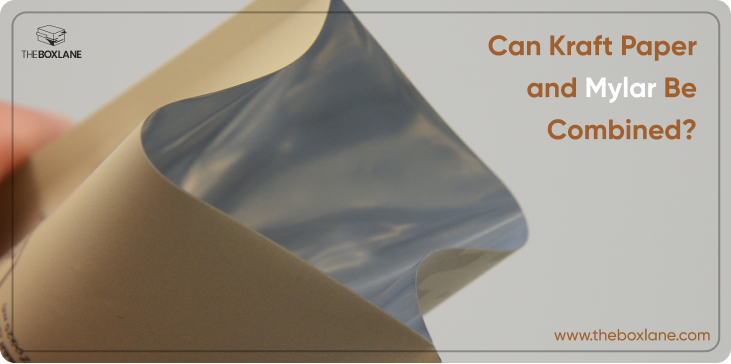
The exterior layer of hybrid packaging includes Kraft Paper, while Mylar forms the lining inside the package. The dual usage of Kraft Paper and Mylar produces a flexible system that delivers sustainable packaging with decorative value and excellent barrier defense properties that appear in coffee bags and food pouches.
12. Pros and Cons of Kraft Paper and Mylar Bags
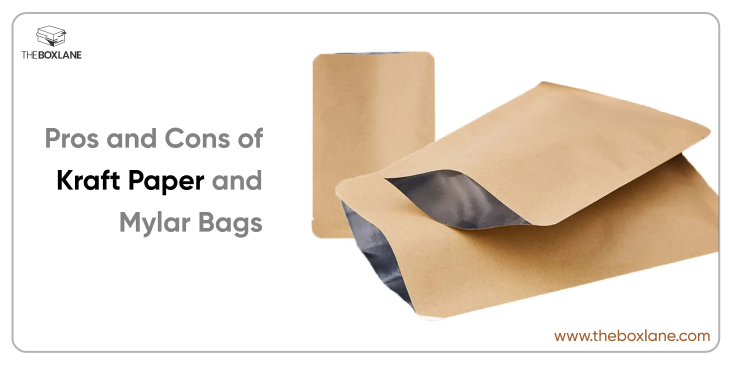
Advantages of Kraft Paper
- Eco-friendly and biodegradable
- Affordable and widely available
- Highly customizable for branding
- Lightweight and easy to handle
Disadvantages of Kraft Paper
- Low moisture and oxygen resistance
- Tears more easily
- Less durable in extreme conditions
Advantages of Mylar
- Excellent moisture, light, and oxygen barrier
- Highly durable and tear-resistant
- Ideal for long-term food storage
- Airtight sealing for freshness
Disadvantages of Mylar
- Not biodegradable
- Higher cost
- Limited customization options
13. Performance Under Extreme Temperatures
Mylar has excellent temperature tolerance that enables it to protect both frozen foods during freeze-drying and vacuum-sealed items. Kraft Paper shows moderate tolerance to heat but cannot survive either cold temperatures or moisture exposure.
14. Tear Resistance: Which Material is Stronger?
Mylar demonstrates better resistance to tearing than Kraft Paper, thus establishing itself as the better choice for protecting items during shipping, along with storage situations.
15. Health Concerns: Is Mylar Safe for Food Storage?
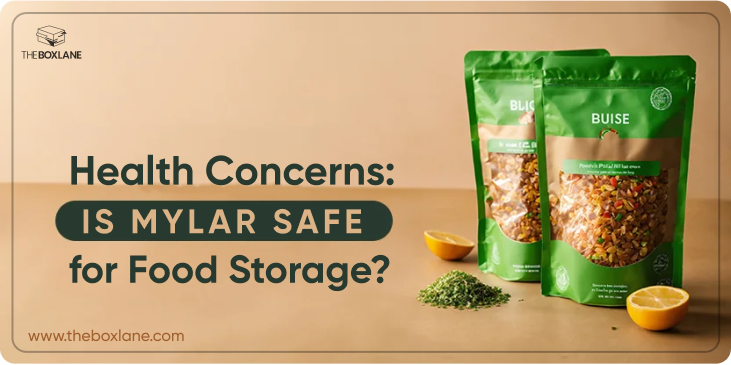
Food-grade Mylar stands as a suitable material for food storage, yet the BPA content must be absent, and the FDA must approve the product to confirm safety from harmful chemicals. Natural Kraft Paper is safe to use, yet unbleached versions without toxic coatings should be selected.
Conclusion: Which Material is Best for Your Needs?
The selection between Kraft Paper and Mylar depends on what specific packaging needs you require. Kraft Paper stands out as the most suitable choice when affordability and environmental protection matter. Mylar stands out as the top material when durability alongside airtightness, and maximum protection are essential requirements. Businesses should look into creating packaging solutions by integrating the best features of Kraft Paper with Mylar to achieve optimal results.
Looking for custom packaging solutions? The Box Lane provides customized high-quality packaging solutions using Kraft Paper and Mylar materials that serve your business requirements.


